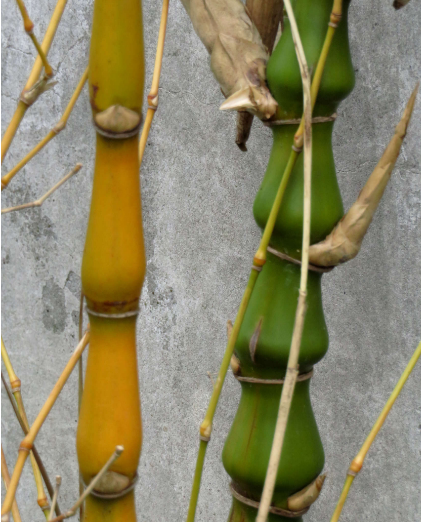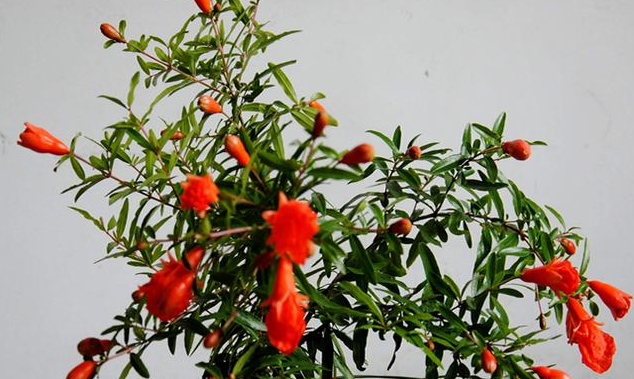What if the leaves of Phyllostachys pubescens turn yellow? what's the price?
Buddha belly bamboo, this kind of bamboo is super good-looking, this Buddha belly bamboo and ordinary bamboo is very different, this Buddha belly bamboo leaves yellow how to do? What is the price of Buddha belly bamboo:

What if the leaves of Phyllostachys pubescens turn yellow?
1. Water yellow: do not accumulate water in the flowerpot. The water is easy to rot, roots and leaves are withered and yellow.
Solution: put the flowers out of the pot in a ventilated, cool, self-drying soil mass and then put them back into the basin.
2. Dry yellow: bamboo likes to be moist, if you ignore watering, or only irrigate the topsoil, the roots do not absorb enough water, and the stems and leaves turn yellow slowly.
Solution: pay attention to watering enough and thoroughly.
3. Burning yellow: bamboo can not shine directly in the strong sun, which will cause withered and yellow branches and leaves.
Solution: just move to a cool place.
4. lack of light and yellow: bamboo likes warmth and is placed in a shady environment for a long time, and the plant grows weakly and then turns yellow. It is best to put it in a place with plenty of sun in winter, if you put it in a place where there is not enough light, coupled with poor ventilation and cold, it is easy to cause withered and yellow branches and leaves.
Solution: supplementing light can avoid this disease.
5. Fat yellow: if the concentration is too high or the fertilizer is not yet ripe, it is easy to burn the seedlings even if they dry up and turn yellow if they are not topdressing for a long time.
Solution: should immediately stop fertilization, seriously wash part of the fertilizer with a lot of washing.
6, lack of fat yellow: to regularly fertilize asparagus, so that it has enough nutrients, nutrients in short supply, there will be the phenomenon of branches and leaves yellowing.
Solution: check the basin soil, if there is a dry phenomenon should change the soil, usually apply thin fertilizer frequently and timely sprinkle some alum (Fugui bamboo is foliage plants should be nitrogen-based fertilizer).
Another reason for the yellowing leaves is the lack of iron. You can buy some ferrous sulfate and put it in the water according to the instructions. The easiest way is to find two small iron nails and put them in the water (preferably rusty nails).
Buddha belly bamboo price:
The price of Buddha belly bamboo has a lot to do with the size of bamboo, this Buddha belly bamboo 3 centimeters costs 10 yuan.
This is the reason for the yellowing of the leaves of Phyllostachys pubescens and the solutions. You can raise a bamboo plant by yourself.
How do the leaves of Phyllostachys pubescens turn yellow? excessive light / improper watering is the key.
In order to make the indoor environment more fresh and beautiful, many people will choose to raise a few pots of plants, and Phyllostachys pubescens is very popular because of its peculiar plant type and green leaves. However, in the process of culturing Phyllostachys pubescens, its leaves will turn yellow because of improper methods, poor environment and other reasons. What is the matter with the yellowing of bamboo leaves? Today, the editor is here to solve this problem for everyone.
First, how do the leaves of Buddha belly bamboo turn yellow?
To say that the leaves of Buddha belly bamboo turn yellow, in addition to environmental discomfort, it is caused by improper maintenance: if the light passes, it needs proper shading; if it is watered too much, the soil is loosened, and when there are rotten roots, it needs to be cut off, and then the pot soil needs to be replanted; if it is caused by alkali, the basin soil can be changed; if it is caused by diseases and insect pests, we need to spray to prevent and control it.
Second, the causes and solutions of the yellowing of bamboo leaves.
1. Environmental mutation
There are many reasons why the leaves of Phyllostachys pubescens turn yellow, and the first thing we should consider is the environment. Nowadays, everyone's potted bamboo plants are basically purchased online, which can easily lead to regional cross-service, the environment changes too much, Buddha belly bamboo can not adapt for a while, resulting in leaf yellow.
Solution: very simple, according to the growth habits of Phyllostachys pubescens, to provide its most suitable growth environment: sufficient astigmatism, slightly wet pot soil, environmental ventilation. After a period of time, the plant will return to health.
2. Excessive illumination
Buddha belly bamboo likes light, and sufficient light can make it grow luxuriantly. However, we need to note that Buddha belly bamboo bogey strong light, once it is exposed to the sun, the chlorophyll in its leaves will be destroyed, the tissue can not carry out normal photosynthesis, resulting in leaves slowly yellowing.
Solution: move the pot of Phyllostachys pubescens to a cool ventilation place in time, wait for it to slow down, and then slowly increase the light, so that the leaves of effective photosynthesis, the leaves will gradually turn green.
3. Improper watering
① insufficient watering: Buddha belly bamboo likes the humid environment, if the watering is too little, the root can not get nutrients, the leaves will naturally turn yellow. Solution: replenish water in time, but don't water too much at once, just keep the basin soil slightly wet.
② overwatering: although Buddha belly bamboo likes water, if it is watered too much, resulting in stagnant water in the basin soil, it will be difficult for the roots to breathe, the roots will rot over a long time, and the leaves will turn yellow because they cannot absorb nutrients. Solution: loosen the soil and let the water evaporate quickly; if the roots have been soaked, the plant needs to be removed from the pot, then cut off the rotten roots and replanted with hearty soil.
4. Soil alkali.
Flower friends who know something about Phyllostachys pubescens know that it likes acidic soil. If the soil is alkaline, or if the soil is alkaline caused by long-term watering of mineral water, the plant will grow poorly, resulting in symptoms of leaf yellow.
Solution: very simple, if the soil is caused by alkali, you can replace the basin soil. Remove the plant from the pot, then replace it with humus soil, pastoral soil, tree soil and fine sand in the ratio of 2 to 1, and then replant it.
5. Diseases and insect pests
In addition to the above points, the yellowing of bamboo leaves may also be caused by diseases and insect pests. The common diseases and insects are shell insects and bamboo locusts, which are mainly attached to the surface of the leaves and absorb nutrients in the leaves, so the leaves turn yellow and wither.
Solution: to determine specific diseases and insect pests, a small amount of direct manual removal, a large number of timely spraying liquid, specific drugs, you can refer to the prevention and control of bamboo diseases and insect pests.
Generally speaking, the cultivation method of Phyllostachys pubescens is not difficult, but because many flower friends are novice, it is inevitable to have the symptom of leaf yellow. However, after reading the full text, I believe you have a bottom in your mind, and the Ye Huang problem can be remedied in accordance with the above methods. With regard to the yellowing of Buddha belly bamboo leaves, the editor has introduced this, hoping to bring help to everyone.
Buddha belly bamboo over the summer yellow leaves how to do?
The main causes of yellowing of Phyllostachys pubescens leaves in summer are as follows: the air is dry and the hot sun is too long, the chlorophyll is destroyed, the bamboo leaves are brown for a long time, the whole leaves are scorched yellow, the nutrients are insufficient, the new bamboo shoots are thin and small, and the old leaves become yellow quickly; diseases and insect pests are harmful; when the plant enters the dormant period, the leaves will naturally wither and yellow.
In view of the above reasons, corresponding measures can be taken, such as the basin soil should be cultivated with loose and fertile soil, water conservation and fertilizer conservation, and families can mix mountain mud and organic fertilizer to compost and prepare.
- Prev

What if the potted pomegranate doesn't blossom or bear fruit? what's the price?
To talk about this pomegranate, this is what many people like to eat, this pomegranate is so delicious, this pomegranate can also be potted, this potted pomegranate does not blossom or bear fruit? How much is the price of potted pomegranate: what if potted pomegranate does not blossom or bear fruit: in fact
- Next

Propagation methods of Chinese Yam
Propagation methods of Chinese Yam
Related
- Fuxing push coffee new agricultural production and marketing class: lack of small-scale processing plants
- Jujube rice field leisure farm deep ploughing Yilan for five years to create a space for organic food and play
- Nongyu Farm-A trial of organic papaya for brave women with advanced technology
- Four points for attention in the prevention and control of diseases and insect pests of edible fungi
- How to add nutrient solution to Edible Fungi
- Is there any good way to control edible fungus mites?
- Open Inoculation Technology of Edible Fungi
- Is there any clever way to use fertilizer for edible fungus in winter?
- What agents are used to kill the pathogens of edible fungi in the mushroom shed?
- Rapid drying of Edible Fungi

